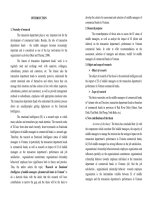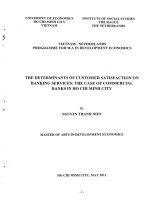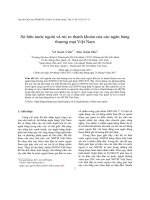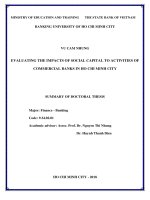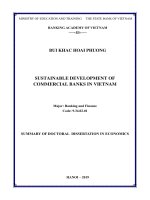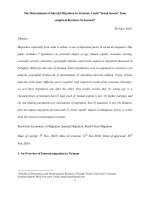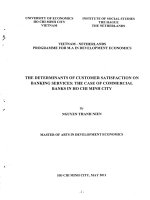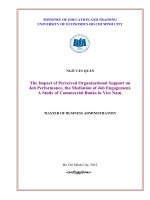THE DETERMINANTS OF LIQUIDITY RISK OF COMMERCIAL BANKS IN VIETNAM
Bạn đang xem bản rút gọn của tài liệu. Xem và tải ngay bản đầy đủ của tài liệu tại đây (1.69 MB, 94 trang )
MINISTRY OF EDUCATION
STATE BANK OF VIETNAM
BANKING UNIVERSITY OF HO CHI MINH CITY
-------------------------
DUONG HA MY
THE DETERMINANTS OF LIQUIDITY RISK OF
COMMERCIAL BANKS IN VIETNAM
GRADUATE THESIS
BANKING AND FINANCE
MAJOR ID: 7340201
ADVISOR
PH.D. NGUYEN DUY LINH
Ho Chi Minh City, September 2021
MINISTER OF EDUCATION
STATE BANK OF VIETNAM
BANKING UNIVERSITY OF HO CHI MINH CITY
-------------------------
DUONG HA MY
THE DETERMINANTS OF LIQUIDITY RISK OF
COMMERCIAL BANKS IN VIETNAM
GRADUATE THESIS
BANKING AND FINANCE
MAJOR ID: 7340201
ADVISOR
PH.D. NGUYEN DUY LINH
Ho Chi Minh City, September 2021
i
ABSTRACT SUMMARY
The topic name: The determinants of liquidity risk of commercial banks in
Vietnam.
The main goals of the study are to find out factors that can explain the liquidity
risk in Vietnamese commercial banks and evaluate their influence levels on the risk.
After that, several policy implications and recommendations will be proposed to
enhance the liquidity ability of banks and prevent sudden liquidity shock.
The study’s contents include: Firstly, the appearance of the study comes from
the demand in limiting the risk of liquidity in commercial banks in the context of
intense competition among banks. Secondly, the study makes a review of previous
domestic and foreign research determining factors affecting liquidity risk to consider
them as a theoretical basis and inherit the research models. Thirdly, the source of
research data is collected from the financial reports of 25 commercial banks in
Vietnam during the period from 2010-2020. Fourthly, the author uses plenty of
methods from qualitative (description, comparison, analysis...) to quantitative
methods. Particularly, the panel data in research is regressed by implementing Pooled
OLS, FEM, REM, and FGLS models. Finally, based on research results, the analysis,
comments as well as conclusion are all demonstrated, to propose the author’s
suggestions in staving off the liquidity risk in banks’ process of operation.
The author hopes that this study can be a partial contribution to the research
in the future as a reference and the research results are somehow useful to bank
administrators, policymakers, and other scholars.
ii
DISCLOSURE
This study has never been submitted to any university for the completion of a
graduate thesis. Except for the fully referenced citations in this thesis, this thesis is
the author's original research effort, the research results are honest, and there are no
contents previously published or created by others.
I take full responsibility for this statement.
Ho Chi Minh City, September 2021
The thesis’s author
Duong Ha My
iii
ACKNOWLEDGMENTS
The author would like to express a vote of thanks to all the teachers of Banking
University of Ho Chi Minh City for supporting, helping, and directly educating and
imparting scientific knowledge specialized in Finance – Banking major, which is the
foundation for the author to accomplish this thesis and apply it in practice. Especially,
I sincerely appreciate the scientific orientation role of a Ph.D. Nguyen Duy Linh in
guiding, supporting, and commenting for my research paper on the topic “The
determinants of liquidity risk of commercial banks in Vietnam”.
I also would like to show my thankfulness to my family and friends for always
supporting me, believing in me, and being the encouragement for me to complete this
thesis.
Due to the limitations in experience and knowledge of the author, the
shortcomings are inevitable. I am looking forward to receiving comments and advice
from the teachers.
Sincerely thanks.
Ho Chi Minh City, September 2021
The thesis’s author
Duong Ha My
iv
COMMENTS OF ADVISOR
......................................................................................................................................
......................................................................................................................................
......................................................................................................................................
......................................................................................................................................
......................................................................................................................................
......................................................................................................................................
......................................................................................................................................
......................................................................................................................................
......................................................................................................................................
Ho Chi Minh City, September 2021
ADVISOR
Ph.D. Nguyen Duy Linh
v
CONTENTS
CHAPTER 1:
INTRODUCTION ...........................................................................1
1.1. Introduction ...................................................................................................1
1.2. Objectives of the study ..................................................................................2
1.2.1.
General objectives ...............................................................................2
1.2.2.
Particular objectives ............................................................................2
1.3. Research questions ........................................................................................2
1.4. Research’s subject and range.........................................................................2
1.4.1.
Research’s subject ...............................................................................2
1.4.2.
Research’s range..................................................................................3
1.5. Scientific and practical significance ..............................................................3
1.6. Research methodology ..................................................................................3
1.6.1.
Research model ...................................................................................3
1.6.2.
Research methodology ........................................................................5
1.6.3.
Research process .................................................................................6
1.6.4.
Data collecting and analyzing .............................................................7
1.7. Research content ............................................................................................7
CHAPTER 2:
LITERATURE REVIEW ..............................................................10
2.1. Theoretical foundations of bank liquidity ...................................................10
2.1.1.
The definition of bank liquidity ........................................................10
2.1.2.
Supply and demand of liquidity ........................................................10
2.1.2.1. Supply of liquidity .........................................................................10
2.1.2.2. Demand of liquidity .......................................................................11
2.1.2.3. Net liquidity status .........................................................................12
2.2. Theoretical foundations of liquidity risk .....................................................13
2.2.1.
Definitions of liquidity risk ...............................................................13
2.2.2.
Causes of liquidity risk ......................................................................13
2.2.3.
Liquidity risk and performance of banks ..........................................14
2.2.4.
Liquidity risk measures .....................................................................15
2.2.4.1. Liquidity risk ratios .......................................................................15
vi
2.2.4.2. Financing gap.................................................................................16
2.3. Literature review..........................................................................................17
2.4. Factors affecting liquidity risk.....................................................................19
2.4.1.
Internal factors ...................................................................................19
2.4.1.1. Return on assets (ROA)..................................................................19
2.4.1.2. Net interest margin (NIM) .............................................................20
2.4.1.3. Bank size (SIZE) ............................................................................20
2.4.1.4. Equity ratio (CAP) .........................................................................21
2.4.1.5. Total loans ratio (TLA) ..................................................................21
2.4.1.6. Operating expenses ratio (CEA) ....................................................21
2.4.1.7. Total deposits ratio (TDES) ...........................................................21
2.4.2.
External factors..................................................................................22
2.4.2.1. Inflation rate (INF) ........................................................................22
2.4.2.2. Economic growth rate (GDP) ........................................................22
CHAPTER 3:
RESEARCH METHOD.................................................................25
3.1. Proposing a research model .........................................................................25
3.2. Variables’ descriptions ................................................................................26
3.2.1.
The dependent variable – Liquidity risk measure (LIQ) ...................26
3.2.2.
The independent variables .................................................................26
3.2.2.1. Return on assets (ROA)..................................................................26
3.2.2.2. Net interest margin (NIM) .............................................................26
3.2.2.3. Bank size (SIZE) ............................................................................27
3.2.2.4. Equity ratio (CAP) .........................................................................27
3.2.2.5. Total loans ratio (TLA) ..................................................................27
3.2.2.6. Operating expenses ratio (CEA) ....................................................27
3.2.2.7. Total deposits ratio (TDES) ...........................................................28
3.2.2.8. Inflation rate (INF) ........................................................................28
3.2.2.9. The economic growth rate (GDP) .................................................28
3.3. Research methodology ................................................................................30
vii
3.3.1.
Research process ...............................................................................30
3.3.2.
Research sample and descriptive statistics ........................................32
3.3.2.1. Research sample ............................................................................32
3.3.2.2. Descriptive statistics ......................................................................35
3.3.3.
Research methodology ......................................................................36
3.3.3.1. Models used for panel data ............................................................37
3.3.3.2. Choosing an appropriate model .....................................................38
3.3.3.3. Tests for defects of the chosen model ...........................................39
CHAPTER 4:
RESEARCH RESULTS ................................................................41
4.1. Research results ...........................................................................................41
4.1.1.
Test of multi-collinearity ...................................................................41
4.1.1.1. Correlations between variables ......................................................41
4.1.1.2. VIF ratio.........................................................................................42
4.1.2.
Regression results of three models: Pooled OLS, FEM, and REM ..43
4.1.3.
Choosing a suitable model ................................................................44
4.1.3.1. Choosing between Pooled OLS and FEM .....................................44
4.1.3.2. Choosing between FEM and REM ................................................45
4.1.4.
Tests for defects of FEM model ........................................................45
4.1.4.1. Test for heteroskedasticity .............................................................45
4.1.4.2. Test for autocorrelation .................................................................45
4.1.5.
FGLS regression ................................................................................46
4.1.6.
Comparison between models ............................................................47
4.1.7.
Results summary ...............................................................................48
4.2. Results discussion ........................................................................................49
CHAPTER 5:
CONCLUSION AND RECOMMENDATIONS ..........................53
5.1. Research conclusion ....................................................................................53
5.2. Policy implications and recommendations for Vietnamese commercial
banks to limit the liquidity risk .............................................................................54
5.2.1.
For commercial banks .......................................................................54
5.2.2.
For the State bank ..............................................................................55
viii
5.2.3.
For the Government...........................................................................55
5.3. Limitations of the study and next research directions .................................55
5.3.1.
Limitations of the study .....................................................................55
5.3.2.
Next research directions ....................................................................56
REFERENCE ............................................................................................................58
ix
LIST OF ACRONYMS
No.
Acronym
Meaning
1
CAP
Equity ratio
2
CEA
Operating expenses to total assets ratio
3
FGLS
Feasible generalized least squares model
4
GDP
Economic growth rate
5
INF
Rate of inflation
6
LIQ
Liquidity risk measure
7
NIM
Net interest margin
8
POLS
Pooled ordinary least squares model
9
ROA
Return on assets ratio
10
ROE
Return on equity ratio
11
REM
Random-effect model
12
TDES
Deposits to total loans ratio
13
TLA
Total loans to total assets ratio
x
LIST OF FIGURES
Figure 1-1: Research process ......................................................................................6
Figure 3-1: Research process ....................................................................................32
LIST OF TABLES
Table 3-1: Variables descriptions .............................................................................29
Table 3-2: List of commercial banks in the research sample ....................................33
Table 3-3: Descriptive statistics ................................................................................35
Table 4-1: Correlations between variables................................................................41
Table 4-2: VIF test ....................................................................................................42
Table 4-3: Results of Pooled OLS, FEM, and REM .................................................43
Table 4-4: Results of FGLS model ...........................................................................46
Table 4-5: Comparison between models ...................................................................47
Table 4-6: Results summary .....................................................................................48
1
CHAPTER 1: INTRODUCTION
1.1. Introduction
There has been a shortage of temporary liquidity in several banks in Vietnam
since 2012 (Tran et al., 2019). Since then, increasing attention is paid to liquidity risk
management to strengthen the trust of customers as long as avoid banking system
crashes.
Theoretically, the liquidity of commercial banks is defined as the ability of a
bank to fund increases in assets and meet obligations as they come due, without
incurring unacceptable losses. The fundamental role of banks in the maturity
transformation of short-term deposits into long-term loans makes banks inherently
vulnerable to liquidity risk (BIS, 2008). Indeed, the Basel Committee (2009)
explained that the viability of commercial banks depends on the liquidity position of
banks. Diamond and Dybvig (1983) were the first to provide evidence on the vital
role of the bank in the creation of liquidity. In addition, Moussa (2015) also insisted
that the liquidity risk level is strongly linked to effective banking operations, therefore,
if liquidity is not generated properly, it may lead to insolvency when liquidity risk is
high and low profitability in case of excessively low liquidity risk.
Banks’ liquidity risk is not a new topic since there are several types of research
in this area in different economies and regions in the world. However, this topic will
never be outdated. As long as the bank systems exist and develop, studies on this
topic are still considered essential to keep up with the changes in society and policies
of the country.
The factors affecting liquidity risk can be classified into two groups which are
internal determinants and external ones. The internal factors are bank size, capital
ratio, credit risk, NIM, deposit ratio, ROA, ROE; and the externals include Inflation
rate in the economy (INF) and Economic growth (GDP).
2
This paper aims to analyze how those determinants affect bank liquidity risk
in Vietnam. Based on the analyzed results, several recommendations will be
suggested for the more stable liquidity of Vietnamese commercial banks in the future.
1.2. Objectives of the study
1.2.1. General objectives
The general objectives of this research are to analyze the determinants of
liquidity risk of Vietnamese commercial banks, then suggest some practical
recommendations to enhance liquidity systems in banks and build a solid defense
against liquidity risk.
1.2.2. Particular objectives
Finding out and examining the determinants affecting liquidity risk of
commercial banks in Vietnam.
Verify the impact levels, impact directions of those determinants on the
liquidity risk of commercial banks in Vietnam.
Proposing practical recommendations and policies for a better liquidity system
of Vietnamese commercial banks.
1.3. Research questions
This study will focus on the following questions:
(i)
What factors affect the liquidity risk of commercial banks in Vietnam?
(ii)
What are the impact levels of these factors? Which one affects the
liquidity risk of the banking system positively and negatively?
(iii)
What solutions can be taken to improve and maintain the optimal
liquidity level and avoid the sudden liquidity risk for Vietnamese
commercial banks?
1.4. Research’s subject and range
1.4.1. Research’s subject
The subject of this study is the liquidity risk of commercial banks in Vietnam.
3
1.4.2. Research’s range
The sample of the research is collected from financial reports of 25
commercial banks which are listed on stock exchanges in Vietnam in the period from
2010 to 2020.
1.5. Scientific and practical significance
The research results of this thesis can be used for reference purposes by
administrators, policymakers, and scholars to contribute to improving the efficiency
of the bank's operations as well as in banking research and administration.
1.6. Research methodology
1.6.1. Research model
The model that will be estimated in this study is:
LIQ = β0 + β1*ROAit + β2*NIMit + β3*SIZEit + β4*CAPit+ β5*TLAit + β6*CEAit +
β7*TDESit + β8*INFt + β9*GDPt +εit
In which:
LIQ =
𝑻𝒐𝒕𝒂𝒍 𝒍𝒊𝒒𝒖𝒊𝒅 𝒂𝒔𝒔𝒆𝒕𝒔
𝑻𝒐𝒕𝒂𝒍 𝒂𝒔𝒔𝒆𝒕𝒔
LIQ is the dependent variable that indicates the liquidity position of the bank,
depicting the bank's ability to absorb liquidity shocks. In theory, the higher the
liquidity ratio, the better the bank can deal with stochastic withdrawals (Chawigza,
2004), and, in contrast, the lower the risk of liquidity level.
ROA = Return On Assets =
𝑵𝒆𝒕 𝒊𝒏𝒄𝒐𝒎𝒆
𝑻𝒐𝒕𝒂𝒍 𝒂𝒔𝒔𝒆𝒕𝒔
Return on assets reflects the efficiency of the banks in assets utilizing (Tran et
al., 2019).
NIM =
𝑵𝒆𝒕 𝑰𝒏𝒕𝒆𝒓𝒆𝒔𝒕 𝒊𝒏𝒄𝒐𝒎𝒆
𝑻𝒐𝒕𝒂𝒍 𝒂𝒔𝒔𝒆𝒕𝒔
4
NIM indicates the efficiency of financial intermediation (Hamadi and Awdeh,
2012).
SIZE = Size of the bank = natural logarithm of total assets
Size can show the economies of scale. The large banks benefit from economies
of scale which reduces the cost of production and information gathering (Boyd and
Runkhle, 1993).
CAP =
𝑻𝒐𝒕𝒂𝒍 𝒆𝒒𝒖𝒊𝒕𝒚
𝑻𝒐𝒕𝒂𝒍 𝒂𝒔𝒔𝒆𝒕𝒔
This ratio measures the proportion of equity to total assets.
TLA =
𝑻𝒐𝒕𝒂𝒍 𝒍𝒐𝒂𝒏𝒔
𝑻𝒐𝒕𝒂𝒍 𝒂𝒔𝒔𝒆𝒕𝒔
TLA shows the weight of total loans over the total assets of banks. Since loans
are illiquid assets, the higher this ratio is, the higher liquidity risk the bank will be
vulnerable to.
CEA =
𝑶𝒑𝒆𝒓𝒂𝒕𝒊𝒏𝒈 𝒆𝒙𝒑𝒆𝒏𝒔𝒆𝒔
𝑻𝒐𝒕𝒂𝒍 𝒂𝒔𝒔𝒆𝒕𝒔
Operating expenses include personal expenses and other expenses (Moussa,
2015). CEA shows the percentage of operating expenses in the total assets.
TDES =
𝑻𝒐𝒕𝒂𝒍 𝒅𝒆𝒑𝒐𝒔𝒊𝒕𝒔
𝑻𝒐𝒕𝒂𝒍 𝒂𝒔𝒔𝒆𝒕𝒔
Deposits comprise demand deposits and term deposits. TDES illustrates the
proportion of total deposits to the total assets.
INF = Rate of inflation
INF shows the increase in the price index.
5
GDP = Gross domestic product
GDP is primarily used to assess the health of a country's economy. Banks tend
to hold more liquidity reserves during recession periods due to loan risks. Conversely,
in periods of economic growth with higher interest rates, banks reduce liquidity
reserves to increase lendings (Tran et al., 2019).
1.6.2. Research methodology
To overcome the weaknesses of each method and increase the reliability of the
research results, the study uses both qualitative methods, quantitative methods, and
other methods at the same time. While the quantitative method is used to detect the
relationship and correlation between variables, the qualitative method is used to
verify the results of data analysis.
Data collecting methods: Developing research framework, designing study
sample, and collecting data for the study. To have data for the research, the author
uses the method of secondary data collection by taking the data in the annual reports,
cash flow statements, business results published on the websites of commercial banks
in the period 2010-2020.
Data processing method: After being collected, data will be calculated as
variables by using Microsoft Excel software. Then, these variables are processed
through the econometric models (Pooled OLS, FEM, REM) on statistical software –
Stata 14.
Quantitative method: Implementing the multivariate regression model.
Qualitative method: Several methods such as description, synthesis,
comparison, and analysis will be used to point out the determinants influencing the
liquidity risk of commercial banks and build a suitable research model.
6
1.6.3. Research process
Figure 1-1: Research process
Step 1: Review background theory and
previous studies
Step 2: Build model and research methods
Step 3: Analyze the impact of the
determinants on liquidity risk
Pooled OLS
Build and
design
variables
Process
Data
Analyze
regression
FEM, REM
Step 4: Test the regression model
Step 5: Analyze the regression results and
discuss the research results
Step 6: Suggest policy implications and
limitations of research
(Source: Compiled by author)
7
1.6.4. Data collecting and analyzing
Panel data are collected through an observational sample of 25 Vietnamese
joint-stock commercial banks listed on the stock exchanges in the period from 2010
to 2020. These data are collected from their financial statements. Besides, the
macroeconomic data are collected on the websites of the State Bank and General
Statistic Office.
1.7. Research content
There will be five chapters in total in this study, which are organized for
presenting separated tasks. Those chapters and the aim of each one will be briefly
shown below:
Chapter 1: INTRODUCTION
This chapter introduces the topic and the necessity of the paper. Besides,
research objectives, research questions, subject, and the scope of research are
determined in this part. Moreover, the meaning and contribution of the research are
also clarified in the first chapter.
Chapter 2: LITERATURE REVIEW
Chapter 2 presents the theoretical basis of liquidity, liquidity risk and clarifies
the factors influencing liquidity risk, including internal and external ones. Then
previous studies with similar topics will be summarized to give an overview of
determinants affecting bank liquidity risk.
Chapter 3: RESEARCH METHOD
This chapter presents the research model, explains variables, calculates and
determines the expected effect of variables. Also, research data, methods, and ways
to run the research model will be illustrated in the third chapter.
8
Chapter 4: RESULTS ANALYSIS AND DISCUSSION
Chapter 4 gives the results of regressing the research model; then the analysis,
evaluations, and comments on those results will also be presented. This chapter will
answer the first two research questions mentioned in section 1.4. Particularly, the
factors affecting liquidity risk and their impact levels will be estimated.
Chapter 5: CONCLUSION AND RECOMMENDATIONS
Based on the results obtained from the previous chapter, chapter 5 will resystematize the entire results of the research process and suggest some solutions to
prevent liquidity risk and enhance liquidity quality in Vietnamese commercial banks.
Besides, there are also mentions of the limitations of the study and the directions for
the next research.
9
CONCLUSION CHAPTER 1
In chapter 1, the topic’s name and the essentials of the paper have already been
introduced by the author. Also, research objectives, research questions, subject, and
scope are all clarified. In addition, the task of presenting the research method, the
meaning, and the contribution of the study has also been completed.
10
CHAPTER 2: LITERATURE REVIEW
The aims of chapter 2 are to give clear and detailed theoretical foundations of
bank liquidity and liquidity risk, such as what they are, how important they are to
commercial banks in Vietnam; and provide definitions of factors considered to have
impacts on liquidity risk. The empirical research is also reviewed to provide an
overview of the relationship between the liquidity risk of banks and those
determinants.
2.1. Theoretical foundations of bank liquidity
2.1.1. The definition of bank liquidity
Basel Committee (2008) defined bank liquidity as the ability of a bank to fund
increases in assets and meet obligations in time without experiencing losses. This
means that banks are in good liquidity status when holding a suitable amount of
available capital or having the capability of immediately raise capital through
borrowing or selling assets. This is because most banks’ liquidity demands are usually
instantaneous. In reality, there are many cases that banks’ liquidity problems stem
from the liquidity problems of customers. When they face a liquidity shortage, they
tend to take bank loans or withdraw their deposits. And that partially affects liquidity
in a negative way.
2.1.2. Supply and demand of liquidity
2.1.2.1.
Supply of liquidity
Trương Quang Thông (2010) assumed that supply of liquidity is the bank's
source to meet liquidity needs, including:
-
Cash and cash equivalents: This is considered one of the most major and
essential sources for the immediate liquidity needs of banks.
-
Customers’ deposits: This is also the main source of liquidity of banks. To
attract deposits, there are some methods banks should apply, such as adjust
deposit rates, provide promotions, improve banks’ reputation...
11
-
Credits refunded by the customers: This is the main profit-making activity
of banks, using deposit capital to commit credits and earn interest payments.
-
Selling assets: When the bank meets liquidity demand, it can exchange a
part of assets into cash.
-
Market Loans: Banks can borrow money in the monetary market from
other commercial banks, which can afford large and immediate liquidity
needs.
-
Borrowing from the central bank: Banks can also borrow short-term loans
from the central bank at a discount rate.
2.1.2.2.
Demand of liquidity
Trương Quang Thông (2010) assumed that liquidity demand is the need to pay
for the committed financial obligations of the bank, including:
-
Depositor's withdrawal demand: This is the main source of liquidity
demand, which is permanent, instantaneous, and unconditional, including
non-term deposits, payment deposits, term deposits, and the number of
deposits that can be withdrawn before maturity. Banks always have to
maintain the liquidity reserves that can meet these withdrawals.
-
Providing credits to customers: Credit activities bring a large source of
income but also contain risks such as capital loss, affecting the solvency of
the banks.
-
Repaying due loans: This includes repayments of loans borrowed from
other banks, central banks, and other repurchase agreements.
-
Operating and tax expenses: This includes all of the expenses related to the
bank’s operation such as salaries, bonuses, electricity and water use,
advertising expenses, tax...
-
Dividend payments: Dividend payments for banks’ shareholders.
12
2.1.2.3.
Net liquidity status
Net liquidity status is calculated by subtracting the value of liquidity supply
from the value of liquidity demand of banks (Trương Quang Thông, 2010). In which,
3 cases may occur:
-
Liquidity surplus: This happens when liquidity supply exceeds liquidity
demand and the amount of liquidity sources is redundant. According to
Thông (2013), the surplus in liquidity shows the inefficiency of the
economics and the lack of business opportunities; or the bank’s inability to
approach the market and customers. In this case, banks need to invest more
in riskier assets that bring higher profits.
-
Liquidity deficit: This happens when liquidity supply is overwhelmed by
liquidity demand and there is a shortage of liquidity sources. The
consequences of a liquidity shortage can cause more serious problems for
the bank's existence and development such as losing business opportunities,
losing customers, losing market share, losing the public’s trust... Therefore,
the bank’s manager has to find out promptly how to mobilize the liquidity
sources and how much it costs.
-
Liquidity balance: The liquidity is called balanced only when the liquidity
supply equals liquidity demand. However, this is nearly impossible in
reality.
Since there is a trade-off between liquidity and profitability, every bank should
have a suitable liquidity policy for its own. Banks have to give up several profit
opportunities if they want to maintain a high liquidity level. In contrast, using a low
liquidity level will bring higher income but that may lead to a liquidity deficit, which
threatens banks with unexpected risks. In conclusion, banks considered to have a
good liquidity status are the banks can access adequate, immediate, and cost-effective
liquidity sources whenever they have demands.
13
2.2. Theoretical foundations of liquidity risk
2.2.1. Definitions of liquidity risk
The definition of the Basel Committee on Banking Supervision indicates that
liquidity risk occurs when a financial institution lacks the capital to meet its
obligations without affecting its daily business operation and financial situation.
Therefore, it faces a failure to supply sufficient cash for immediate liquidity needs
(Tran et al., 2019). In other terms, liquidity risk can be defined as the risk of being
unable to liquidate a position timely at a reasonable price (Muranaga and Ohsawa,
1997).
2.2.2. Causes of liquidity risk
Goodhart (2008) assumed that there are two basic facets of liquidity risk:
maturity transformation (the maturity of a bank’s liabilities and assets) and the
inherent liquidity of a bank’s assets (the extent to which assets can be sold without
incurring a significant loss of value under any market condition). Maturity
transformation occurs when there is a mismatch of duration between assets and
liabilities, such as mobilizing and borrowing short-term funds while lending and
granting credit at long-term duration (Duttweiler, 2009). The latter cause – the
inherent liquidity of a bank’s assets – may stem from matured liabilities that can not
be covered in time, which forces that bank to sell its assets at lower prices than their
true values. However, it is believed that these two are intertwined with each other. If
banks hold enough assets that have high liquidity levels, they can feel secure about
the maturity transformation. On the other hand, if banks possess assets that are going
to mature in a short period, it is still fine to not keep a large number of liquid assets.
Nguyen (2013) suggested that there is also a relationship between liquidity
risk and the sensitivity of financial assets to interest rates’ fluctuation. When the
interest rates in the financial market vary, banks with lower interest rates payment
will lose depositors to banks paying higher interest rates. Meanwhile, customers who
have credit demand may try to delay payment for a due debt or get more funds from
